How to facilitate meetings that are worth everyone’s time and help you accomplish your goals.
How many meetings have you attended this week where the only decision made was to schedule another meeting? More than you’d like to admit?
Unfortunately, we’ve found this is the predominant outcome of most meetings. In our recent survey of 5,000 knowledge workers, 77% of respondents say they frequently attend meetings that end in a decision to schedule a follow-up meeting. Even worse, 54% of workers frequently leave meetings without a clear idea of next steps or who owns which task.
Meetings that end without clear outcomes are not only ineffective – they are demotivating and waste valuable time that could be put toward priority work. It’s time we stop meeting like this.
I lead the Team Anywhere Lab at Atlassian, a group of behavioral scientists dedicated to designing and validating the best ways to work for modern teams. We conducted an experiment to help teams run more productive, less frustrating meetings.
Why don’t traditional meetings work?
Traditional meetings rely on slides or a few people talking to set the context of why the meeting is taking place and the decisions that need to be made. These ways of meeting don’t work because:
- Meetings don’t get to the point fast enough. Too much of the meeting time is spent setting the stage. Participants are stuck waiting to understand specific meeting goals and what is needed from their participation. Once discussion is underway, participants are often rushed for time.
- Slides are not created with the audience (or objective) in mind. Slides often fail to clarify the main message, discussion points, and intended outcomes for participants. As a result, slides are more of an info dump than a helpful tool for making decisions in real time.
- Presenters and participants aren’t on the same page. Attendees can no longer refer to information once a presenter has moved forward, or are distracted clicking around slides while the presenter talks.
- Decisions made in meetings aren’t documented. There is rarely a record of the meeting for anyone who wasn’t there. If someone does take notes or record the call, they may be buried in someone’s computer. More often than not, the context that led to the outcome usually gets lost.
The page-led meeting experiment
We (and many others at Atlassian) have adopted a different way to meet we call “page-led meetings.” My team designed an experiment to validate through research whether the use of a high-quality written page, in fact, facilitates more effective meetings.
A page, for the purposes of our experiment, is a high-quality written document that lays out needed context, meeting goals, and key decisions. Participants read the page at the beginning of the meeting to quickly get the information they need to have a productive group discussion that moves work forward or arrives at a decision.
Thirty-four Atlassians from across the company were split into two groups. The control group facilitated a meeting as they typically would. The second group took a course on how to facilitate a meeting with a page. They were asked to use what they learned to write a page and facilitate a meeting with it.
After their meetings, we surveyed the meeting attendees and facilitators (104 Atlassians in total) about their experience. We also analyzed the pages used to facilitate the meetings.
Our experiment shows that page-led meetings are:
- Less frustrating and more energizing
- Rated as a better use of time
- More likely to accomplish team goals
Reduce meeting friction to achieve your goals
Our data shows that Atlassians who attended page-led meetings were 29% more likely to feel energized after the meeting and 23% less likely to feel frustrated. Making meetings a more positive experience removes the friction that can come when participants are confused, frustrated, or disengaged.
To this point, our model indicates that page-led meetings led to higher attendee energy and lower attendee frustration, which in turn led to higher goal accomplishment. In fact, 85% of page-led meetings accomplished their goals (versus 69% of control meetings).
Having a structured page allowed us to hit the ground running with ideas already percolating. This led to efficient, productive discussion and more time for actionable outcomes.
Ankitha N., People Operations
Engage meeting participants through a crisp, clear page
Our data shows that those who attended a page-led meeting by a facilitator who had received training consistently rated it as a better use of time than those in the control group. Pages created by those in the training group were on average shorter (3-minute read on average) than those in the control group who chose to use a page, but had not received training (5.7-minute read).
The page-led framework worked particularly well for a large group, as it gave everyone a turn to speak – which is usually a challenge.
Max B., individual contributor
The results show that the approach is valuable for both meeting participants and facilitators. 14 out of 16 meeting facilitators would recommend the approach they learned in the training to a colleague.
The experiment helped me to understand the importance of planning for meetings, and communicating clearly and simply
Jessica C., senior manager
Ready for better meetings? Learn how to run a page-led meeting in the Atlassian Team Playbook.


